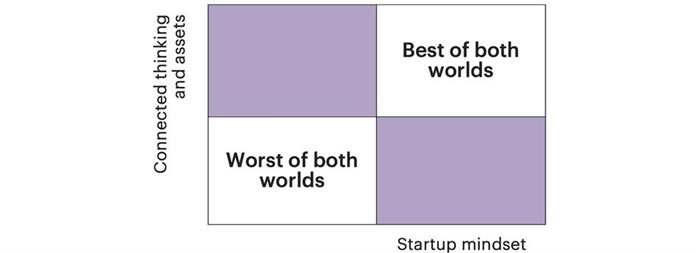How businesses can be innovative without losing their core focus

So as a large corporate, how can you manage this need to grow the core business – that has made you successful – while also being innovative and creating the new? Assuming this is relevant to your business, here are five things to consider:
1. Not an either/or debate
You must grow the core and create the new. Most organisations are trying to do either one or the other, which doesn't work. Given the speed of change, if you're focused on growing the core, you will likely miss the plot, and likewise, if you're only thinking about creating the new, you will also lose out. A good balance is necessary where you do both at various stages of the business life cycle. It is a constant process to discover, execute, assess and repeat.
2. Not a once-off
Many organisations think of it as a short exercise that is done when a need arises. They will innovate and create the new, and once they figure it out, they can stop. It is not the case, and it is not a once-off solution to a growth dilemma but rather a constant journey you must encounter frequently.
3. A clear choice - worst or best of both worlds
Let's consider the matrix below. One axis portrays how you think about connected thinking and assets, while the other is your startup mindset.

Ideally, you want to be in the top right quadrant where you incorporate connected thinking and assets and have a startup's agility. Unfortunately, most corporates are stuck in the bottom left – the worst of both worlds. Imagine a retailer recognises an ample opportunity in the market and decides to launch a new business in something they were not doing before. If they disregard their current assets, partners and customer base, they will enter with a lean startup mentality.
Copying lean startup methods and tools when you're not a startup is hardly advisable, but many corporates still opt to compete with startups at the startup level. They try to create the new by competing with the same tools a startup has, ignoring what they have in the core business. It makes it very hard for them to succeed because they struggle with making quick decisions, innovating, taking risks and failing. They're not fully applying the startup mentality or mindset, but they're also not leveraging the connected thinking and assets they have in their core business.
4. Ecosystem-centric
A lot of organisations have been through what I call cycles around centricity. At one point, organisations were very product-centric. They then moved to be arguably customer-centric and, more recently, employee-centric. However, you must be ecosystem-centric to grow the core while creating the new. This approach means including ecosystem partners in your business journey to success. It implies including vendors and manufacturers at the centre of your thinking rather than as an afterthought. So, it is not only about the product and customer and employee, but also the partner.
These partnerships are redefined as "unusual partnerships". One clear example of unusual partnerships is when you partner with your competition or a competitor of one part of your business. The advantage is shared learning and experiences. One has to be highly focused on what you should be doing versus what others can do for you.
5. Future-looking mentality
Lastly, you need to take a longer-term view of what is core for you. It means having a future-looking mentality. If you take the example of Tesla, what is its core? Is it manufacturing, software, artificial intelligence or something else? Once you have clarity, you can decide how to leverage partners to do things that may not be your core business and what the partner might be better at delivering. Trying to accomplish this can be almost impossible. So you must become razor-focused on what you do versus what others do for you.
Is all of this practical?
Playing in the best of both worlds is challenging but achievable. Are there a lot of companies in South Africa and the world that do this now? No, not many, because it is hard. The five things are straightforward but practically hard to implement alone. You need to prioritise and focus by asking what your core business is? Is it a fantastic product? Is it the distribution power of the company? Can you partner with another organisation to achieve better results than on your own? The point is to start shifting the mindset and doing both as a process. Otherwise, it is easy to fall into the trap of not doing anything at all and risk missing out on exponential growth.
About the author
- Medical aid cover for physical rehabilitation and physical therapy in South Africa, by Medshield 28 Mar 2024
- Understanding digestive health and the gut microbiome, by Medshield 25 Mar 2024
- The AEL shares how young South Africans can be custodians of our eco-sensitive future 31 Jan 2024
- Mapping Conservation Ecology as a multi-disciplinary and integrated field of study - The AEL 25 Jan 2024
- Studying a higher certificate in Conservation Ecology – The AEL 24 Jan 2024
StoneStone provides excellent strategy counsel, engagement consulting and communication services. We support our clients' business goals on their journey to success and prosperity. |